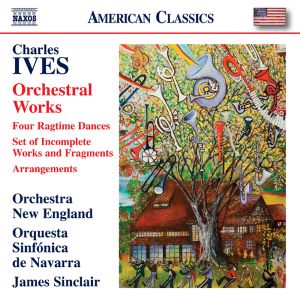
Charles Ives (1874-1954)
Orchestral Works
Orchestra New England, Orquesta Sinfónica de Navarra/ James Sinclair
rec. 2023/24, Auditorio Barañáin, Pamplona, Navarra, Spain; Colony Hall, Choate Rosemary Hall, Wallingford, USA
Naxos 8.559954 [75]
Here is a curiosity: twenty tracks of mostly unknown works by Charles Ives, many between one and three minutes. Much of the music is great fun in Ives’s idiosyncratic, devil-may-care manner, and it is never dull for a moment. Chromâtimelôdtune, the weirdest piece here, has a title that sounds forbidding but it does not take itself too seriously. It is based on a 12-note melody but ends on a C major chord. This, at six and a half minutes, and the Tone Roads No.1 and No.3 (about three and half minutes each) are the most substantial works, and the most engaging.The Ragtime Dances are crazily entertaining as only Ives can be. (Correction: so can Mauricio Kagel!) According to the conductor James Sinclair’s notes, each of these is based on three hymn tunes. “This juxtaposition of the sacred and profane fits Ives’s lifelong quest to find unity in all humanity.”
The almost equally entertaining Marches No.2-3 are from Ives’s late teens. I wonder whether actual marching bands adopted such pieces. If not, why not?On Fugue in Four Keys on ‘The Shining Shore’ (a hymn tune), James Sinclair writes: “[…] an example of the kind of experimentation that once annoyed Ives’s music professor at Yale in the late 1890s”. The piece does create, in spite of the four keys, “a rather beautiful harmonic haze”.
The title An Old Song Deranged is promising, but – Sinclair reckons – self-mocking. Would the innocent ear guess that Ives composed such a piece? This beautifully harmonious arrangement seems the least deranged music on the disc, especially when juxtaposed with the following Skit for Danbury Fair – a return to Ives’s mad world. (Danbury, Connecticut was Ives’s native city.)
Ives’s arrangements of Schubert and Schumann, the least interesting items here, were presumably included for curiosity value.
One has to be a devoted Ivesian to record all this almost totally unknown music, let alone compile the Incomplete Works and Fragments (track 14). The orchestras, both unknown to me, give fine performances. (I wonder what the Navarra players would have made of Ives’s pieces.) I am not sure that I would want to hear the Berlin Philharmonic or Vienna Philharmonic in this repertoire.
The booklet notes are all that could be desired. The delightful front cover pictures is brilliantly appropriate: a detail from James Bigelow Hall’s 2007 painting Charles Ives Symphony #3.
Philip Borg-Wheeler
Previous review: Ken Talbot (October 2024)
Contents
Charles Ives (1874 – 1954)
Four Ragtime Dances (1902–04, rev. 1916)
Fugue in Four Keys on “The Shining Shore” (c. 1903)
The Pond (c. 1906, rev. c. 1912–13)
The Rainbow (1914) (version 1)
An Old Song Deranged (c. 1903)
Skit for Danbury Fair(c. 1909) (incomplete)
The Gong on the Hook and Ladder or Firemen’s Parade on Main Street
(c. 1911) (version for ensemble 1934)
Chromâtimelôdtune (c. 1923)
Tone Roads No. 1(c. 1913–14)
Tone Roads No. 3 (c. 1911/1913–14)
Set of Incomplete Works and Fragments (sequenced and edited by Kenneth Singleton
and James Sinclair, 1974)
March No. 2, with “Son of a Gambolier” (c. 1892)
March No. 3, with “My Old Kentucky Home” (c. 1893)
March: The Circus Band (c. 1898–99/1932–33)
Franz Schubert (1797–1828)
Marche militaire in D major, Op. 51, D. 733, No. 1(1818) (arr. C. Ives, 1896–97)
Four Impromptus, Op. 90, D. 899 – No. 1 in C minor(1827) (arr. C. Ives)
Robert Schumann (1810–1856)
Carnaval, Op. 9 – No. 4. Valse noble (1834–35) (arr. C. Ives)
Buying this recording via a link below generates revenue for MWI, which helps the site remain free




















